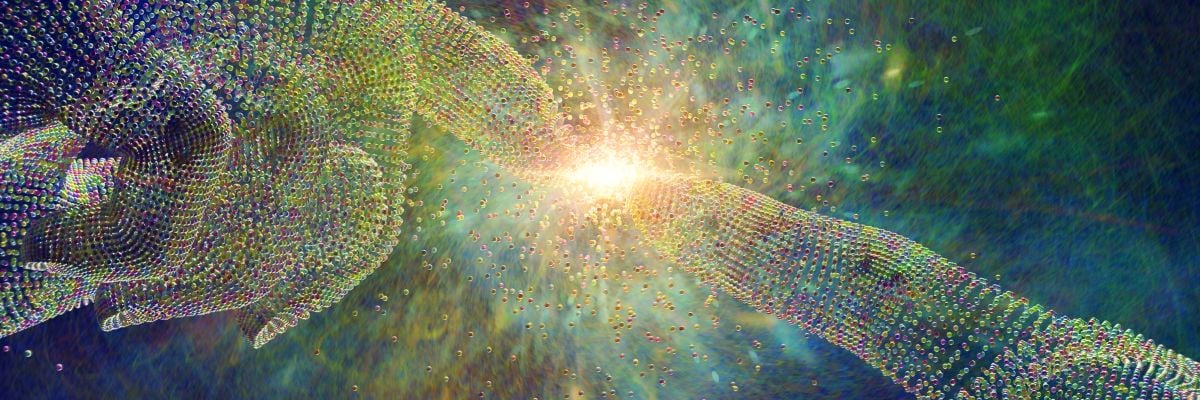
Evidence for a Beginning
The Borde-Vilenkin-Guth, or BVG, theorem shows that any universe with an average expansion rate greater than zero could not have been expanding forever.
Based on the expansive nature of space (a theory originally proposed by Fr. Georges Lemaître in 1927), and the inverse proportionality of recessional and relative velocities (as recessional velocities increase, relative velocities decrease, and vice versa), the BVG theorem shows that the relative velocities of objects would increase as one would trace them back into the past.
In their 2003 essay “Inflationary Spacetimes are Not Past-Complete,” published in the peer-reviewed scientific journal Physical Review Letters, cosmologists Arvin Borde, Alexander Vilenkin, and Alan Guth explain and successfully defend this theorem.
This means that at some point a finite time ago these relative velocities would have been virtually at the speed of light. And since the velocity of physical energy cannot exceed the speed of light according to current scientific knowledge, there must have been a boundary to past time, and thus a beginning. Given that the only condition for the theorem to work is an average expansion rate greater than zero, the theorem remarkably applies to almost all model universes, even multiverses (many bubble universes in one mega universe) and all bouncing universes that do not begin with a contraction.
If time, space, and matter had an absolute beginning, and something can’t come from sheer nothingness, then it’s reasonable to conclude that there must be some sort of cause outside time, space, and matter that chose to bring it all into existence.
“It is said that an argument is what convinces reasonable men and a proof is what it takes to convince even an unreasonable man. With the proof now in place, cosmologists can no longer hide behind the possibility of a past eternal universe. There is no escape: they have to face the problem of a cosmic beginning” —Alexander Vilenkin, Many Worlds in One, p. 176
More Evidence for a Beginning
The law of entropy—or the second law of thermodynamics—states that as an isolated energetic system uses its energy, if left to itself without any sort of outside influence it will move progressively from a state of order (low entropy) to disorder (high entropy) in an irreversible process. The reason for this is that the state of disorder is statistically more probable than the state of order.
Our universe is a gigantic, energetic system progressively moving from a state of order (low entropy) to disorder (high entropy) as it uses its energy to do useful work. And it’s common scientific knowledge that at some time in the far distant future (60 to 100 billion years) the universe will eventually reach a state of maximum entropy, or what in the technical jargon is referred to as thermodynamic equilibrium (in a layman’s term, “heat death”).
Now, if the universe had been around for an infinite amount of time and had been using its energy and moving progressively from order to disorder in an irreversible process, then it stands to reason that the universe would have already reached a state of maximum entropy. All the usable energy would have been used up, resulting in non-usable energy (like the cosmic microwave background radiation).
But it’s obvious that our universe hasn’t reached such a maximum state of entropy; otherwise, you wouldn’t be reading this article. Therefore, based on scientific evidence, it’s reasonable to conclude that the universe (also the multiverse or an oscillating universe) could not have been existing for an infinite amount of time and thus must have had a beginning. And if a beginning, then there would be a need for a transcendent Creator. Unless you think something can come from sheer nothingness.
“There has been no verifiable evidence that the laws of thermodynamics have been violated throughout the universe. Atheists may cloud the air when they blow forth their unreasonable, unproven theories, but when the fairy-dust settles, the laws of thermodynamics still declare the truth to all who will listen (Ps. 19:1). The scientific evidence shows that there is unmistakable order and design in the Universe. Design implies a Designer. Now, that’s scientific.” —“The Laws of Thermodynamics Don’t Apply to the Universe!”, Apologetics Press
Finely Tuned Universal Constants
Universal constants are those fixed numerical quantities used in the equations of physics and that control the laws of nature. For example, in the equation E=MC2, C is the constant for the speed of light (approximately 186,000 miles per second).
The oddity of these constants is that they could have had any numerical quantity at the Big Bang, higher or lower, but they just so happened to have the exact value needed in order for our universe to house life—from the simplest to the most complex (you and me).
For example, if the values of the gravitational constant or the weak force constant varied higher or lower by one part in 1050 (.00000000000000000000000000000000000000000000000001), the universe would have either exploded in its initial expansion or collapsed into a black hole. Suffice to say that if this happened there would be no life (see Paul Davies, The Accidental Universe, 107). This is just one example among many examples that are too numerous to list here.
Such razor-edge fine-tuning at least gives credence to the belief that a super-calculating intellect set the values of the universal constants at the beginning of the universe to be what they needed to be for the universe to house life forms.
“A common sense interpretation of the facts suggests that a superintellect has monkeyed with physics, as well as with chemistry and biology, and that there are no blind forces worth speaking about in nature. The numbers one calculates from the facts seem to me so overwhelming as to put this conclusion almost beyond question.” —Sir Fred Hoyle, director of the Institute of Astronomy at Cambridge University
Finely Tuned Initial Conditions
According to the calculations of Oxford University emeritus professor Roger Penrose, the odds against the ordered energy (low entropy) at the beginning of the universe were 1010123 to 1 (The Emperor’s New Mind, 343).
That degree of improbability is virtually beyond our comprehension. If you wrote this number with a single exponent, it would be 10 with the exponent’s number being a one with 123 zeroes behind it! That number is impossible to write out without an exponent; in fact, Penrose says, there would be more zeroes in it than there are particles in the entire universe (Ibid., 343). That’s a big number.
Compare it with the odds of getting dealt a royal flush fifty straight times in a poker game. The odds for one royal flush are around 1 in 650,000. But to make things simpler, let’s suppose it’s 1 in a million (1/106). By this number, the odds of getting fifty straight royal flush hands by pure chance would be 1/10300. Despite how incredibly improbable this is, the odds of getting dealt fifty straight royal flushes every day for the rest of your life are still incalculably better than the probability of low entropy being present at the beginning of the universe.
If it’s unreasonable to believe the highly improbable event of being dealt fifty straight royal flush hands by pure chance, then wouldn’t it also be unreasonable to believe that the vastly more improbable event of the low entropy at the beginning of the universe happened by pure chance?
Our experience of intelligence being the source of events that are extremely improbable gives us reason to believe that the improbability of the fine-tuning of the universe also has a designing intelligence as its source.
“The scientist who has lived by his faith in the power of science has scaled the mountains of ignorance; he is about to conquer the highest peak; as he pulls himself over the final rock, he is greeted by a band of theologians who have been sitting there for centuries” —Robert Jastrow, American physicist, astronomer, cosmologist, and founder/former director of the NASA Goddard Institute for Space Studies



